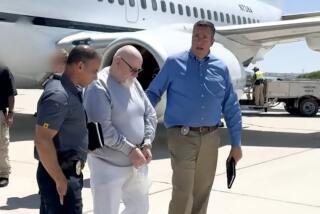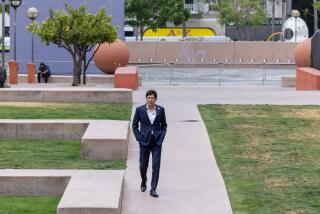Arrest Shreds Genial Image Decades in the Making
- Share via
COLUMBIA, S.C. — The world that Gerald F. Mason made for himself was the very picture of middle-class convention.
He ran a gas station, then retired with his wife to a staid subdivision where all the houses are brick and brown and all the streets are a variation of the name Patio. He was a genial fellow who checked up on neighboring widows and was always willing to lend a hand with a man’s traditional chores: painting a mailbox or fixing an electrical problem. He golfed weekly and was a better-than-average bowler. He drove a Buick.
On Thursday, those trappings suddenly seemed dizzyingly remote as Mason, 68, stood in a jail inmate’s jumpsuit and Los Angeles County investigators outlined evidence linking him to the slayings of two El Segundo police officers in 1957.
Mason, who was arrested Wednesday at his home after Los Angeles detectives tied him to the killings through a chance fingerprint match, signaled during a brief hearing at the Richland County jail that he would fight extradition to California on charges stemming from a crime rampage that ended with the fatal shooting of Officers Milton Curtis and Richard Phillips on July 22, 1957. Mason is also charged with kidnapping and robbing four teenagers at gunpoint, and raping one of them, on a lover’s lane in Hawthorne a short time earlier.
Los Angeles investigators disclosed at the hearing that the fingerprint allegedly tying Mason to the crime, which police found on the dusty door of the 1949 Ford that the killer had driven, was a digital composite put together from two partial fingerprints -- a technological feat that would have been impossible in 1957, and that will probably attract close scrutiny by defense attorneys.
Sheriff’s officials said detectives had uncovered other physical evidence that appeared to link Mason to the killings. This includes unspecified evidence showing that Mason was in Shreveport, La., four days before the killings, according to Sheriff’s Capt. Frank Merriman. That was the place and time that the murder weapon, a .22-caliber revolver, was purchased at a Sears store, he said.
Police officials said Wednesday that they had used a single fingerprint from the killer’s stolen car to track down the suspect after it matched prints in a new FBI national database. Those prints were taken from Mason in 1956, when he was arrested and convicted for burglary in South Carolina.
According to Capt. Chris Beattie of Los Angeles County Sheriff’s Scientific Services Bureau, a set of partial fingerprints from the 1957 double homicide lay untouched in a case file until September, when a man on his deathbed said he knew who had committed the murders. That tip turned out to be false, authorities said.
The false tip, however, renewed interest in the case. Stuck with the problem of two partial fingerprints, a forensic identification specialist, Don Keir, went to work. “He used a digital program to make one full print out of two partial prints,” Beattie said. “Don’s work brought this man to justice.”
The fingerprint was run through the state’s fingerprint database and the FBI’s database. The FBI system, known as Universal Latent Workstation, has been available only since February 2002. The system matches a fingerprint with the most similar prints in the database. Experts then evaluate them to determine which is the best match.
Once the match was made, Beattie said, the partial prints, not just the composite, were compared with Mason’s prints by three experts. All agreed that the prints were his, he said.
Photographs of Mason were shown to various witnesses in the case, Merriman said, although he refused to identify the witnesses, describe the circumstances under which they were shown the photos or say whether they had identified Mason. Among the potential witnesses are three of the four teenagers.
The .22-caliber pistol was found in the backyard of a Manhattan Beach home, authorities said. A homeowner found a revolver without its cylinder in April 1959, nearly two years after the killings and tossed it on a shelf in his garage. About a year later, the homeowner was rototilling his backyard when he heard a metallic sound and discovered the pistol’s cylinder.
He took the gun and cylinder to police, who said ballistics tests showed it was the murder weapon. Police speculated that the gun had been dropped by the killer as he escaped through Manhattan Beach on foot, hopping fences and crossing yards.
Shortly after that discovery, investigators obtained the records of the gun purchase from the Shreveport Sears. The buyer was listed as G.D. Wilson, who gave a fictitious address in Miami. Detectives also found a ledger from a Shreveport YMCA showing that a man registered as George D. Wilson had stayed there at the same time.
Merriman said investigators had obtained copies of Mason’s handwriting but declined to say how they were being used.
Now officially designated a captured fugitive, Mason, tall and balding, was clench-jawed but unshackled behind a steel mesh barrier at the Alvin S. Glenn Detention Center in Columbia as his lawyer, Chris Mills, announced that he would fight extradition. Two of Mason’s brothers waited outside the hearing room but did not speak with reporters.
The crimes for which Mason has been arrested began on what was then an unpaved road used by teenagers as a lover’s lane. Four teenagers -- two boys, 16 and 17, and two girls, both 15 -- said they were held up by an armed man who tied up the boys and one of the girls, and sexually assaulted the other girl. The attacker drove off in the youths’ car.
Not long after, El Segundo officers stopped the car when the driver ran a red light. The gunman fired half a dozen shots, killing Curtis, 25, and Phillips, 28. Police worked the case hard for several years but the trail went cold.
In the suburban neighborhood where Mason lives, his neighbors and friends struggled to reconcile the allegations with the habits of a man they knew as a paragon of respectability.
“This just does not compute with anything I’ve known or thought about Jerry. I just can’t believe it,” said Ruth Archer, a 79-year-old retired secretary whose late husband bowled with Mason regularly. “It doesn’t sound like anything that would happen to Jerry -- or that he would do anything to be a fugitive.”
Mills said Mason was born in Columbia and had lived there for at least the last 40 years. The defense lawyer said he was not familiar with Mason’s professional career, except that Mason had owned a gas station. Mills said his client had no criminal convictions that he knew of since the burglary case.
Mason’s family kept silent Thursday at the couple’s home at Patio Drive and Patio Lane.
Mason had already retired from the gas station business when he and his wife, Betty, moved into the three-bedroom home a decade ago. Few of his neighbors knew much about his life before then, but they consistently described Mason as friendly and considerate, as generous with his time as he was handy with a wrench.
The neighborhood, called Lost Creek Patio Homes, is a tidy enclave of retirees in the semirural outskirts of Columbia, the state’s capital. It’s a tranquil settlement, with an artificial pond and miniature American flags sprouting from the mailboxes. Up and down his street, Mason was known as gregarious and especially watchful of the elderly women who had outlived their husbands. If he didn’t see you leave for a couple of days, neighbors said, Mason was likely to stop by to make sure everything was all right.
He walked frequently to ease back pain, neighbors said, and was sure to offer a hearty hello. Mason was often called upon to troubleshoot problems with swimming pools or cars -- repairs on whatever needed fixing.
“He did a lot of lovely things around the neighborhood for the ladies. He painted mailboxes. He was Mr. Fix-It,” said Erma Wilson, who met Mason when the two of them worked for a printing company in 1960. At the time, Wilson was a typesetter and Mason was a printer, she said.
Mills said he planned to seek Mason’s release at a bond hearing this morning.
*
Ellingwood reported from Columbia and Winton from Los Angeles. Times staff writer Mitchell Landsberg contributed to this report.
More to Read
Sign up for Essential California
The most important California stories and recommendations in your inbox every morning.
You may occasionally receive promotional content from the Los Angeles Times.











